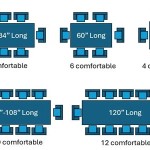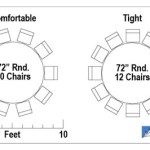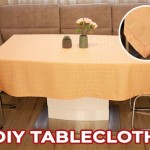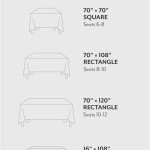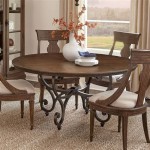How Big Is A 48 Inch Round Table: A Comprehensive Guide
Round tables are a popular choice for dining rooms, kitchens, and even meeting spaces, offering a sense of intimacy and encouraging conversation. When selecting a round table, size is a crucial factor. A 48-inch round table, specifically, is a versatile option that can accommodate a range of needs and space considerations. This article will delve into the dimensions of a 48-inch round table, its capacity, ideal room size, and various applications, providing a comprehensive understanding of its suitability for different environments.
The dimension of a 48-inch round table refers to its diameter, the distance across the circle passing through the center. This measurement is critical for determining how many people can comfortably sit around the table and whether it will fit well within a given room. Understanding the implications of this diameter is the first step in determining if a 48-inch round table is the right choice.
Seating Capacity and Comfort
Determining the seating capacity of a 48-inch round table hinges on the amount of personal space required for each diner. While the table can technically accommodate more, a comfortable dining experience necessitates adequate elbow room. A general guideline is to allocate approximately 24 inches of width per person for comfortable seating. Therefore, to calculate the ideal seating capacity, consider the table's circumference and divide it by the suggested width per person.
The circumference of a circle is calculated using the formula C = πd, where C is the circumference, π (pi) is approximately 3.14159, and d is the diameter. For a 48-inch round table, the circumference is approximately 3.14159 * 48 inches, which equals roughly 150.8 inches. Dividing this circumference by 24 inches per person yields an approximate seating capacity of 6.3 people. While this is a theoretical calculation, in practice, a 48-inch round table comfortably seats 4 to 6 people.
For four people, each person will have ample space. For six people, the seating will be cozier, but still generally comfortable for dining. If the intention is to use the table for activities requiring more personal space, such as board games or crafting, seating fewer than six people is advisable. Conversely, if the table is primarily used for shorter meals or casual gatherings, seating six people may be perfectly acceptable. The type of chairs used also impacts the seating arrangement. Chairs with arms will require slightly more space compared to armless chairs, potentially reducing the overall seating capacity. Consideration of chair dimensions is therefore essential when determining the final seating configuration.
Furthermore, the presence of a centerpiece on the table should be taken into account. A large, elaborate centerpiece can reduce the usable surface area, effectively decreasing the amount of space available for each diner's plates and utensils. A smaller, more minimalist centerpiece, or one that is easily removable, will help maximize the available space.
Room Size and Clearance
Beyond seating capacity, the size of the room is a critical factor in determining the suitability of a 48-inch round table. Adequate clearance around the table is necessary to allow people to move freely, pull out chairs, and navigate the space comfortably. Cramped conditions can detract from the dining experience and make the room feel smaller and less inviting. A widely accepted guideline is to allow at least 36 inches of clearance between the edge of the table and any walls or other furniture. This provides enough space for people to walk behind seated diners without bumping into them or feeling confined.
To calculate the minimum room size required for a 48-inch round table, add the table's diameter to twice the minimum clearance. In this case, 48 inches (table diameter) + 36 inches (clearance) + 36 inches (clearance) equals 120 inches, or 10 feet. Therefore, the minimum room size required to comfortably accommodate a 48-inch round table is a 10-foot by 10-foot square. This allows for the table to be centered in the room with adequate space on all sides.
However, this is a minimum recommendation. Ideally, a larger room is preferred to provide a more spacious and comfortable environment. In a larger room, the table can be positioned further away from walls and other furniture, creating a more relaxed and open atmosphere. Consider the overall layout of the room and the placement of other furniture, such as sideboards, hutches, and seating areas, when determining the ideal table placement. The goal is to create a balanced and harmonious space that is both functional and aesthetically pleasing.
In smaller spaces, compromises may need to be made. Consider using smaller chairs, opting for a narrower clearance, or perhaps choosing a table with a smaller diameter altogether. In some cases, a rectangular table might be a more suitable option, as it can be pushed against a wall when not in use, freeing up valuable floor space. The selection of the appropriate table size and shape should always be informed by the specific dimensions and configuration of the room in question.
Applications and Versatility
A 48-inch round table is a versatile piece of furniture suitable for a variety of applications. Its size makes it ideal for smaller dining rooms or kitchen nooks where space is limited. It can also serve as a breakfast table, a game table, or a small conference table in an office setting. The round shape promotes conversation and collaboration, making it a popular choice for informal gatherings and meetings.
In a residential setting, a 48-inch round table can be used in a dedicated dining room, a kitchen eating area, or even a living room as a focal point for social gatherings. Its compact size makes it well-suited for apartments or homes with limited square footage. The table can be paired with a variety of chair styles, from traditional wooden chairs to modern upholstered chairs, allowing for customization to suit individual tastes and décor.
In a commercial setting, a 48-inch round table can be used in break rooms, cafes, or small meeting rooms. Its size is conducive to small group discussions and collaborative work. The table can be easily moved and reconfigured to accommodate different meeting formats and space requirements. The durability of the table is also a consideration in commercial settings, as it will likely be subjected to more frequent use and potential wear and tear. Choosing a table made from durable materials, such as solid wood or metal, is essential to ensure its longevity and maintain its appearance.
The style of the table can also be adapted to suit different environments and purposes. A table with a simple, minimalist design is ideal for a modern or contemporary setting, while a table with a more ornate or traditional design might be better suited for a more formal or traditional space. The finish of the table can also be chosen to complement the existing décor. Light wood finishes create a bright and airy feel, while dark wood finishes add warmth and sophistication. Metal finishes, such as chrome or brushed nickel, can add a touch of industrial chic.
Ultimately, the versatility of a 48-inch round table makes it a valuable addition to any home or office. Its compact size, comfortable seating capacity, and adaptable style make it a practical and aesthetically pleasing choice for a wide range of applications. By carefully considering the room size, seating requirements, and overall décor, one can confidently select a 48-inch round table that meets their specific needs and enhances their space.
Beyond these considerations, the material composition of the table also contributes to its overall suitability. Tables constructed from solid wood offer durability and aesthetic appeal, though they may require more maintenance. Laminate tables present a more affordable and low-maintenance option, suitable for everyday use. Glass-topped tables provide a modern and airy aesthetic, but may be more prone to scratches and require frequent cleaning.
The height of the table is equally important. Standard dining tables typically stand around 30 inches tall, while counter-height tables are taller and require stools. The appropriate height should be determined based on the intended use and the height of the chairs or stools that will be used with the table.
In conclusion, a 48-inch round table presents a balanced option for smaller spaces, accommodating a comfortable number of diners while fostering an intimate and conversational atmosphere. Careful consideration of room dimensions, seating arrangements, and the intended use of the table will ensure that it serves as a functional and aesthetically pleasing addition to any setting.

48 Round Table Seats 6 8 Party Pros

Tables Table 48 Inch Round

How Many Chiavari Chairs Fit At A 48 Round Table National Event Supply

Lifetime 48 In Round Fold Half Table Almond 80481 The Home Depot

How Many Chiavari Chairs Fit At A 48 Round Table National Event Supply

48 Round Table Seats 6 8 Party Pros

Lifetime 48 Inch Round Fold In Half Table Light Commercial

Lifetime 48 Inch Round Fold In Half Table Light Commercial

Lifetime 48 Inch Round Table Indoor Outdoor Light Commercial Grade Almond 80809 Com

How Many Chiavari Chairs Fit At A 48 Round Table National Event Supply
Related Posts

